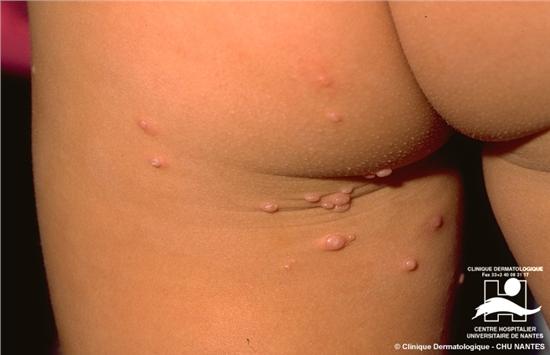What is molluscum contagiosum?
 Molluscum contagiosum is a common and relatively harmless viral infection of the skin. As its name implies, it is contagious (can be caught from another person by direct contact). It is most common in children and young adults, but can occur at any age.
Molluscum contagiosum is a common and relatively harmless viral infection of the skin. As its name implies, it is contagious (can be caught from another person by direct contact). It is most common in children and young adults, but can occur at any age.
What causes molluscum contagiosum?
Molluscum contagiosum is caused by a virus that can be picked up through close personal contact with someone who has it, or from objects such as a shared flannel or a towel. The spots come up after an incubation period of a few weeks. They are more common and extensive in people who have atopic eczema (the type of eczema that runs in families together with asthma and hayfever).
Sometimes people whose immune system is suppressed for any reason, such as taking immunosuppressive treatments may develop large numbers of molluscum contagiosum, but most people with molluscum contagiosum are perfectly healthy.
Is molluscum contagiosum hereditary?
No, though it often affects several members of a family at the same time.
What are its symptoms?
Usually there are no symptoms, but the spots can be itchy or sore if they become inflamed or infected. They can bleed slightly if scratched.
What does molluscum contagiosum look like?
- The spots of molluscum contagiosum are easily recognised: a magnifying glass helps with this. The spots are:
- Small (from 2 to 6 mm. across): rarely they can grow larger than this.
- Raised, and hemispherical (like a tiny dome), with a shiny surface.
- Usually they are skin coloured, though they can be redder or paler than that.
- Their most striking feature is a central pore containing a cheesy plug.
- Sometimes areas of dry redness, rather like eczema, appear around the spots.
- There may be only one or two spots, and usually there are less than 20. They often occur in groups. A few people have more than a hundred spots; and this may hint that their immune system is not working well.
How will molluscum contagiosum be diagnosed?
No tests are usually needed as the spots can easily be recognised by a doctor (see above). They should not be confused with warts, which have a rough surface and no central pore. If a molluscum contagiosum spot becomes inflamed, it can look rather like a boil.
If there is any doubt about the diagnosis, material squeezed out of the central pore of a spot can be looked at under the microscope. Occasionally a solitary lesion can have an atypical appearance and it may then necessary to remove a whole spot for examination under the microscope in order to make the diagnosis.
Can molluscum contagiosum be cured?
Yes. It usually goes away by itself, taking between 3 and 6 months to do so. However it can last for much longer than this, particularly if the body’s defences are not working properly (see above). The spots often become red and inflamed just as they are about to go away, and can leave small depressed scars.
How can molluscum contagiosum be treated?
This depends partly on the age of the person who has it. Many of the treatments are painful and often no treatment at all is needed since the spots can be expected to go away on their own. A child hurt by active treatment may be frightened of doctors for life. If active treatment is needed, there are several possibilities:
- The spots can be frozen with liquid nitrogen (cryotherapy), at intervals of 3 weeks, until they are clear.
- Some simple measures cause the spots to become inflamed and then to go away. These include squeezing the spots out with a pair of forceps, and piercing them with a small sharp stick. A local anaesthetic cream, applied to the area and left on under a plastic film for one hour before the procedure, will help to reduce the pain.
- The spots can be scraped off with a sharp instrument (curettage).
- A cream containing a chemical that affects the immune system (imiquimod) has recently had some success, but should be avoided in pregnancy. Imiquimod is not licenced for treating molluscum contagiosum.
- The most effective treatment is to cauterise them under anaesthetic
What can I do?
You should make every effort not to pass the infection on to others, particularly those in your family. Stick to your own towel, flannel and clothing. However children with molluscum contagiosum need not be kept off school, nor should they be barred from swimming, etc.